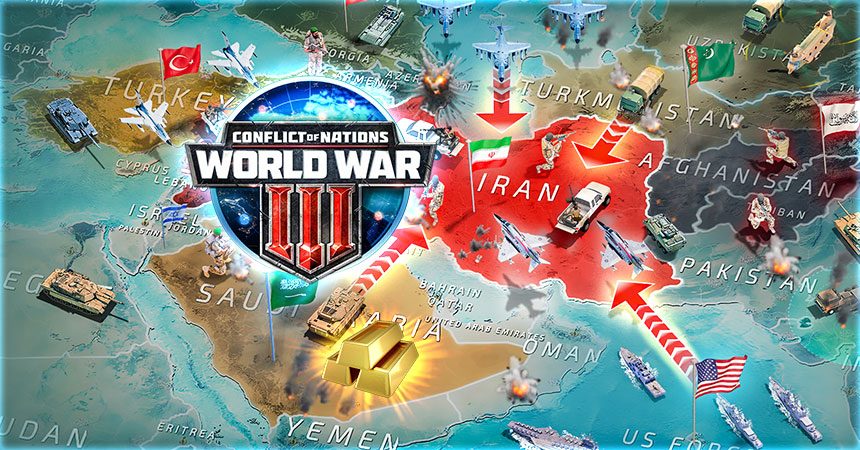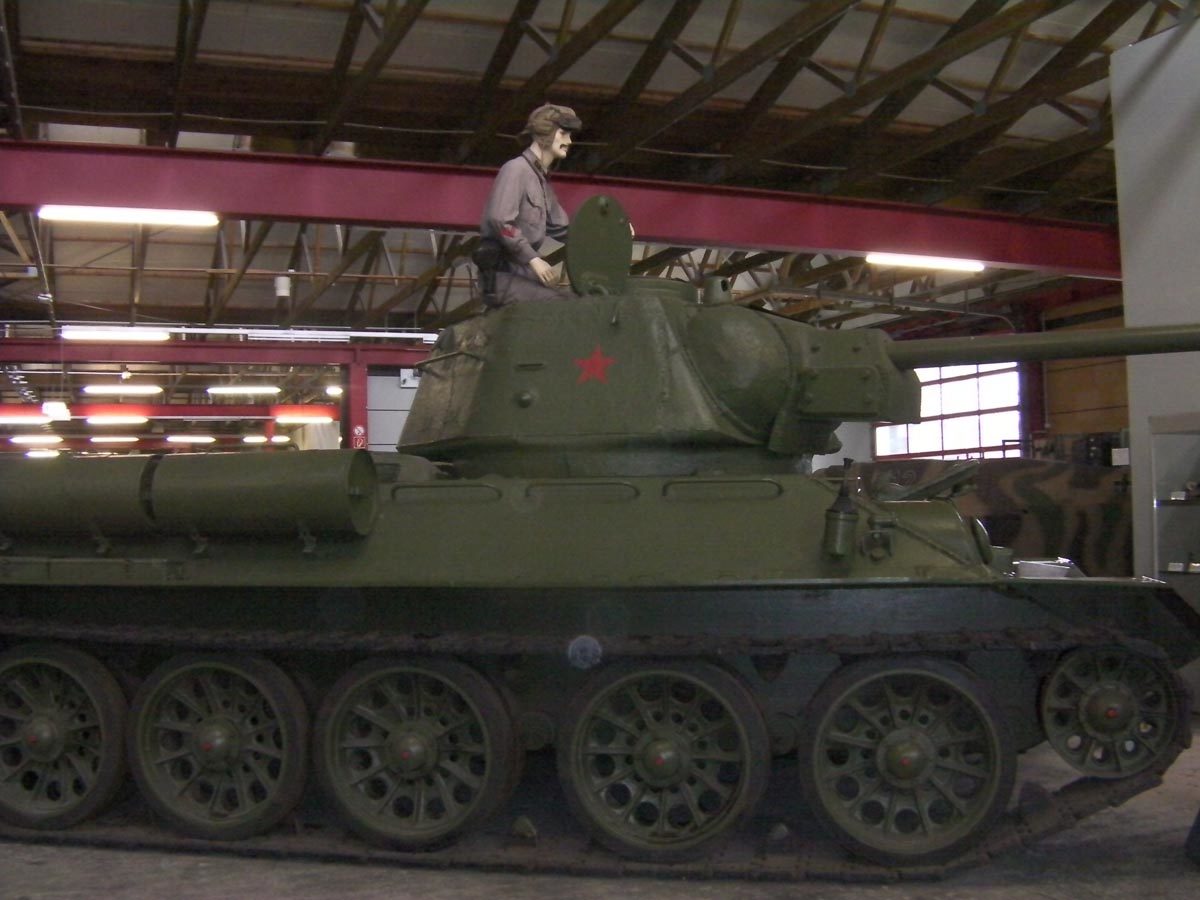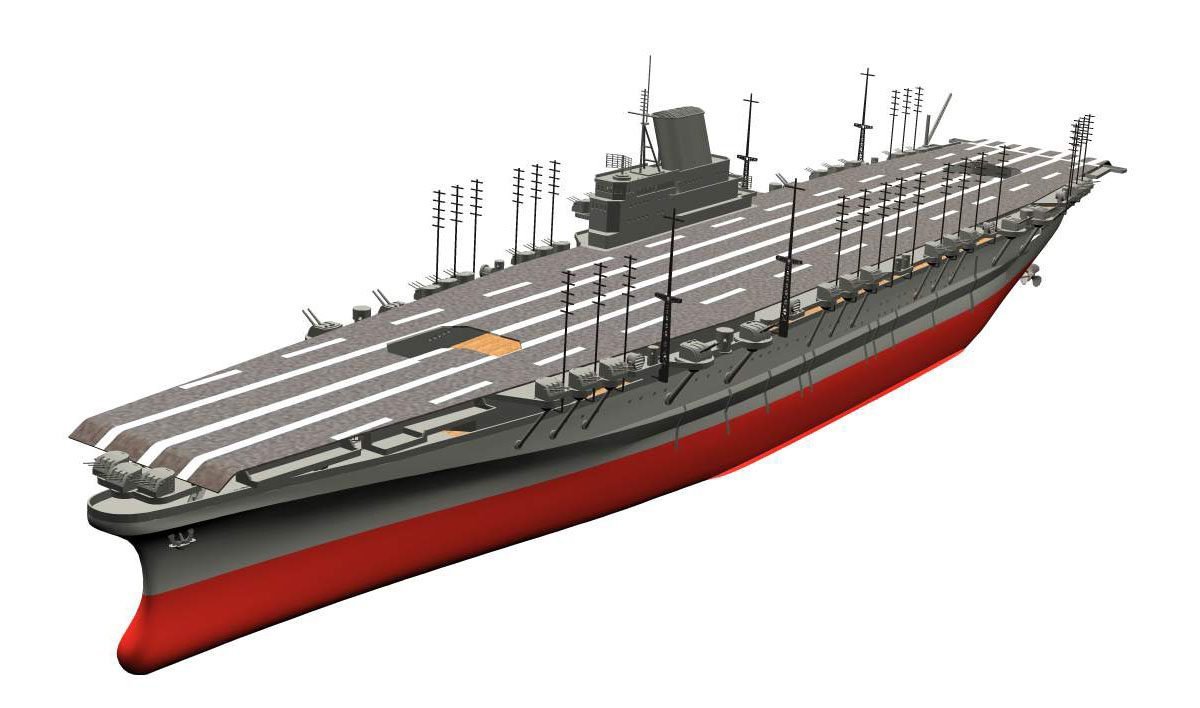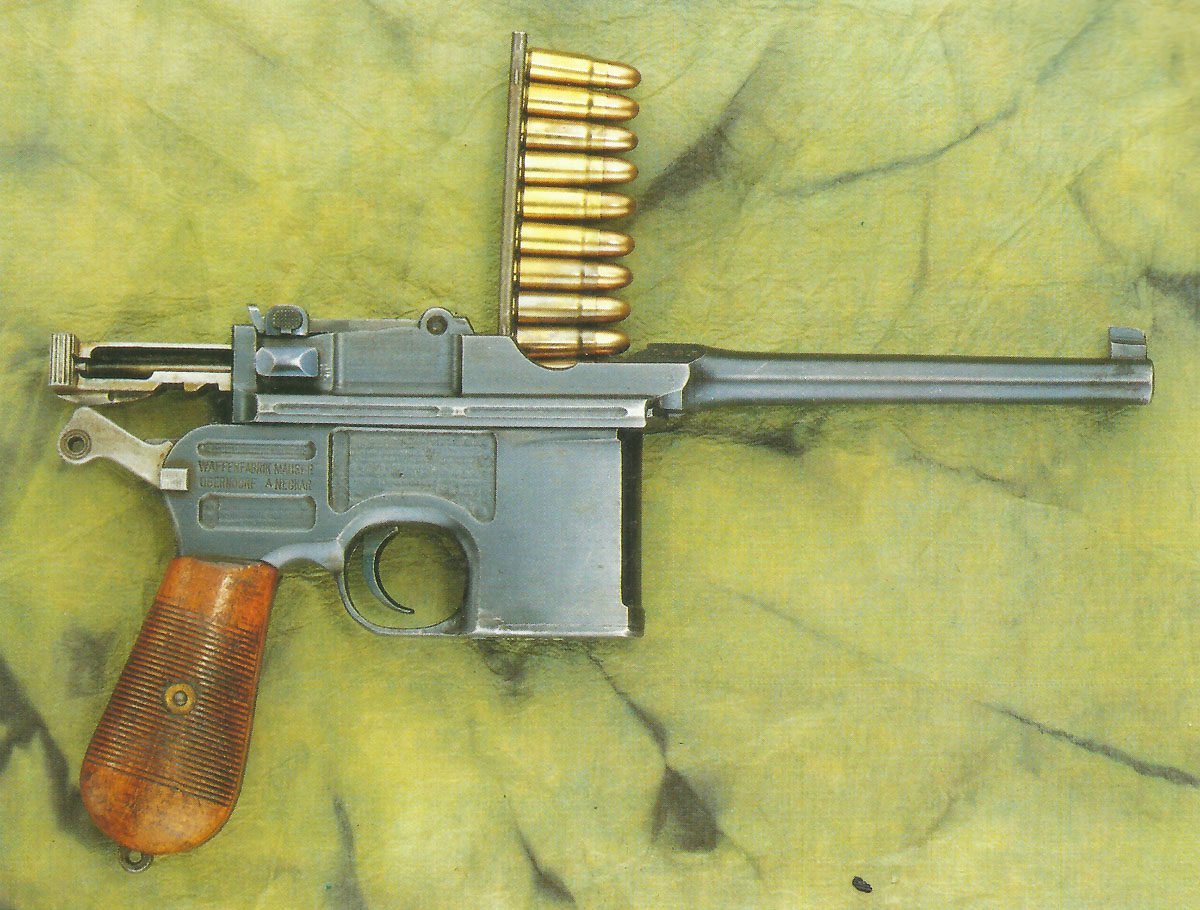German Jagdtiger heavy tank destroyer (SdKfz 186) from the Second World War: the ultimate tank destroyer.
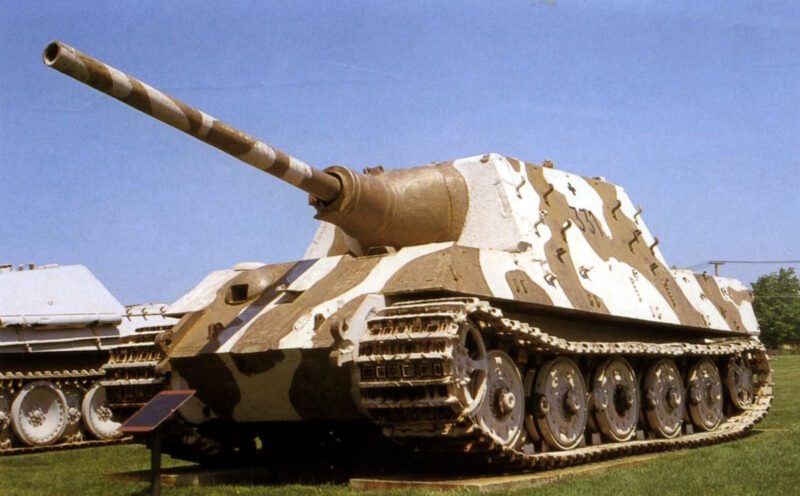
Jagdtiger heavy armoured tank destroyer (Sdkfz 186)
Table of Contents
The Jagdtiger was the largest and heaviest tracked fighting vehicle of World War II, weighing over 70 tonnes. This German heavy tank destroyer was built on a slightly lengthened Tiger II chassis, combining immense firepower with heavy armor protection. The name “Jagdtiger” translates to “Hunting Tiger,” reflecting its predatory design philosophy.
The Sd.Kfz.186 Jagdtiger represented the ultimate expression of German heavy tank destroyer development during the Second World War. As part of the Jagdpanzer (hunting tank) series, it featured a casemate-type design that sacrificed turret rotation for a lower profile and increased armor protection. This fearsome vehicle was developed in 1943 and entered service during the latter stages of the conflict.
Despite its impressive specifications, the Jagdtiger faced significant operational challenges. Its extreme weight limited mobility and bridge-crossing capabilities, while mechanical reliability issues plagued its deployment. These giants served primarily with the 512th Heavy Tank Destroyer Battalion, where their massive presence on the battlefield remained a testament to German heavy armor design philosophy.
Historical Context

The Jagdtiger emerged during the latter stages of World War II as Germany’s heaviest armored fighting vehicle. It represented the culmination of German heavy tank destroyer development, combining massive firepower with unprecedented armor protection.
Development and Production
The development of the Jagdtiger began in 1943 as German military planners sought to create an even more powerful successor to earlier tank destroyers. Designated SdKfz 186 (Special Purpose Vehicle 186), the Jagdtiger utilized a modified Tiger II chassis with a fixed superstructure instead of a turret. This design allowed engineers to mount the formidable 128mm PaK 44 L/55 gun, capable of destroying any Allied tank at extreme ranges.
Production started in 1944 at the Nibelungenwerk factory in Austria. Manufacturing proved challenging due to Germany’s deteriorating industrial capacity and material shortages. Only about 85-88 Jagdtigers were completed before the war ended.
The vehicle featured exceptionally thick armor—up to 250mm at the front—making it virtually impenetrable to Allied anti-tank weapons. This protection came at a cost: the final design weighed a staggering 73.5 tonnes.
Role in the Second World War
The Jagdtiger saw limited combat action due to its late introduction and low production numbers. Most units equipped with these massive tank destroyers were deployed to the Western Front against American and British forces rather than the Eastern Front against Soviet armor.
One notable engagement occurred on March 10, 1945, when Jagdtigers were deployed against American forces at the Remagen bridgehead on the Rhine River. While theoretically devastating in combat, the vehicle’s effectiveness was hampered by numerous practical issues.
Mechanical reliability proved problematic, with breakdowns common due to the immense weight straining the engine and transmission. Fuel shortages in the final months of the war further limited operational mobility. Additionally, Allied air superiority made it difficult to transport these massive vehicles to the front lines without detection.
Design Specifications
The Jagdtiger (SdKfz 186) stood as the heaviest armored fighting vehicle produced by Nazi Germany during World War II. Its design focused on creating an extremely well-protected platform with devastating firepower, though at the cost of mobility.
Armor and Survivability
The Jagdtiger featured exceptionally thick armor protection that made it nearly impervious to most Allied anti-tank weapons of the era. The casemate front measured an impressive 250 mm (9.84 inches) thick, while the hull frontal armor was 150 mm (5.91 inches).
Side armor provided 80 mm (3.15 inches) of protection, as did the rear armor sections. This comprehensive armor scheme gave crews significant confidence when facing enemy fire.
The massive weight resulting from this armor presented mechanical reliability problems. Track and suspension components frequently failed under the extreme pressure of supporting nearly 70 tons of vehicle weight.
Despite its protective advantages, the Jagdtiger’s large profile (10.6 meters long, 3.6 meters wide, and 2.8 meters tall) made it difficult to conceal on the battlefield.
Main Armament
The Jagdtiger’s primary weapon was the formidable 12.8 cm PaK 44 L/55 anti-tank gun. This massive cannon could penetrate any Allied tank at combat ranges.
The gun fired separate-loading ammunition (shell and propellant loaded separately), with each round weighing approximately 28 kg. Ammunition storage was limited to 38-40 rounds due to the size of each shell.
The 12.8 cm gun could penetrate over 200 mm of armor at 1,000 meters, making it capable of destroying any Allied tank from the front. However, the loading process was cumbersome, resulting in a relatively slow rate of fire.
A machine gun mounted in the front provided minimal protection against infantry attacks, a significant vulnerability for such a large vehicle.
Mobility
The Jagdtiger suffered from severe mobility limitations due to its extreme weight of approximately 71 tons fully loaded. Two different powerplants were used across production:
- Maybach HL230 P30 V-12 gasoline engine (700 hp)
- Maybach HL 234 gasoline engine (750-800 hp)
Neither engine provided adequate power for smooth operation. The vehicle’s power-to-weight ratio was a mere 9.8 hp/ton, resulting in a maximum road speed of only 34 km/h (21 mph).
Cross-country performance was even worse, with speeds rarely exceeding 15 km/h. The operational range was limited to about 120 km on roads. The vehicle frequently became immobilized on soft ground or when crossing bridges of insufficient capacity.
Development history
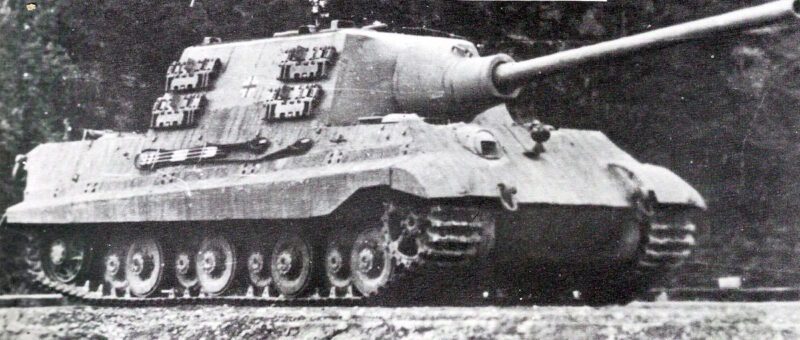
At the beginning of 1943, the order was placed to develop a heavy, self-propelled anti-tank gun by mounting the 12.8 cm gun on a Tiger II chassis.
A wooden model of the huge vehicle was presented on 20 October 1943 and the finished prototype in April 1944. Two Jagdtigers (No. 305001 and 305004) were built with the longitudinal torsion bar suspension designed by Porsche. This proved unsatisfactory and delayed production until the Jagdtiger was redesigned with Henschel torsion bar suspension.
The first series was intended for 150 units, but the order of October 1944 stipulated that after completion of these vehicles, the production capacity was to be used to build the Panther. However, this was cancelled in January 1945 and orders were given to continue the assembly of the Jagdtiger as quickly as possible.
A Jagdtiger with the 8.8-cm Pak L/71 was designated SdKfz 185, but never went into production. However, as there were not enough 12.8 cm Pak 44s available after the manufacturing plant was bombed, some of the Jagdtigers had to be armed with the 8.8 cm Pak 43/3 at the end of the war.
Special features
The Jagdtiger had the same chassis as the Tiger II, but its hull was extended. The superstructure had a very boxy appearance, with the sides created by the continuation of the upper hull walls.
The machine gun mount was retained in the front of the hull as a secondary armament to the 12.8 cm Pak44 mounted in the front of the superstructure.
Service use
The Jagdtiger was only issued to two combat units, the Panzerjägerabteilung 653 (tank destroyer detachment) and schwere Panzerabteilung 512 (heavy tank detachment). The Panzerjägerabteilung 653 was deployed on the Western Front during the Battle of the Bulge and later together with the 512th schwere Panzerabteilung in the defence of Germany, including in the battles for the Remagen bridgehead on 10 March 1945 and subsequently in the Ruhr pocket.
Specifications
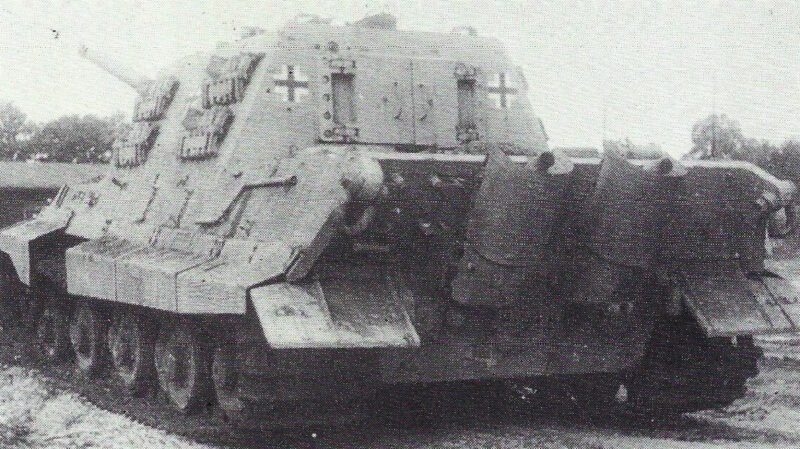
Specifications:
Specification |
Jagdtiger Ausf B |
|---|---|
Type |
heavy tank destroyer |
Engine |
Maybach HL230P30 (700 PS at 3000 rpm, 600 PS at 2500 rpm) |
Gearbox |
Maybach Olvar 40-12-16 with 8 forward and 4 reverse |
Crew |
6 |
Length (over all) |
25.59 ft (7.80 m) – with gun: 34.95 (10.654 m) |
Width |
11.89 ft (3.625 m) |
Height |
9.66 ft (2.945 m) |
Weight |
70 tons |
Maximum road speed |
21.7-23.6 mph (35-38 km/h) |
Cross-country speed |
? |
Fuel consumption per 100 km |
700 liters in road, 1000 liters cross-country |
Fuel |
860 liters |
Road radius |
75 miles (120 km) |
Cross-country radius |
50 miles (80 km) |
Vertical obstacle |
2.79 ft (0.85 m) |
Trench crossing |
8.20 ft (2.50 m) |
Fording depth |
5.74 ft (1.75 m) |
Turning circle |
16.40 ft (5.00 m) |
Climbing power |
35° |
Armor:
Jagdtiger Ausf B |
mm |
Angle |
|---|---|---|
Superstructure front |
250 |
15° |
Superstructure Side |
80 |
25° |
Superstructure Rear |
80 |
5° |
Superstructure Top |
40 |
85° |
Upper Hull Front |
150 |
50° |
Upper Hull Top |
40 |
90° |
Lower Hull Front |
100 |
50° |
Hull Side |
80 |
0° |
Hull Rear |
80 |
30° |
Hull Bottom |
25-40 |
90° |
Armament and Equipment:
Jagdtiger Ausf B |
Specification |
|---|---|
Main armament |
12.8cm Pak44 L/55 |
Rounds |
40 |
Traverse |
10° left – 10° right (by hand) |
Elevation |
-7,5° to +15° |
Effective fire range |
from combat reports: 4,375 yard (4,000 m) |
Secondary armament |
|
Radio |
? |
Telescopic sight |
WZF2/7 (up to 8x zoom) |
Penetration mm at 30° armor plates 12.8cm Pak44 L/55
Range |
Pzgr |
Pzgr43 |
|---|---|---|
100 meters |
189 mm |
? |
500 meters |
175 mm |
215 mm |
1,000 meters |
143 mm |
202 mm |
1,500 meters |
127 mm |
190 mm |
2,000 meters |
117 mm |
178 mm |
Shell weight |
58.20 lb (26.4 kg) |
62,39 lb (28.3 kg) |
Muzzle velocity |
2,822 ft/sec (860 m/sec) |
3,018 ft/sec (920 m/sec) |
Production:
Jagdtiger Ausf B |
Fogures |
|---|---|
Production |
July 1944 – March 1945 |
Price per tank [1 RM = $0.45] |
estimates 210,000 RM |
Total production figure |
77 |
Service statistics Jagdtiger:
Year |
Available |
Production |
Losses |
|---|---|---|---|
pre-1939 |
– |
– |
– |
1939 |
– |
– |
– |
1940 |
– |
– |
– |
1941 |
– |
– |
– |
1942 |
– |
– |
– |
1943 |
– |
– |
– |
1944 |
– |
51 |
0 |
1945 |
41 |
23 (Jan-Feb) |
1 (Jan) |
Insg. |
– |
74 (till Feb 45) |
1 (till Jan 45) |
Operational History
The Jagdtiger saw limited but significant combat during the final stages of World War II. Despite its formidable firepower and armor, mechanical issues and fuel shortages hampered its effectiveness.
Engagements on the Eastern Front
The Jagdtiger’s deployment on the Eastern Front was extremely limited. Most heavy tank destroyer battalions equipped with the Jagdtiger were prioritized for the Western Front to counter American and British armor. Only a small number of these massive vehicles were sent east.
The few Jagdtigers that did see action against Soviet forces encountered similar problems as they did in the west. Their tremendous weight of approximately 73.5 tonnes made them difficult to maneuver in the muddy conditions typical of the Eastern Front.
Bridge crossings proved particularly challenging, as few bridges could support the vehicle’s weight. Mechanical breakdowns were frequent, and recovery of disabled Jagdtigers was nearly impossible given their size and weight.
Deployment in the West
The Jagdtiger saw more extensive action against Allied Forces in the west. On March 10, 1945, these heavy tank destroyers were committed to battle against the American bridgehead at Remagen on the Rhine River. This marked one of their most significant deployments.
Schwere Panzerjäger-Abteilung 512 and 653 were the primary units equipped with Jagdtigers. Despite their impressive 128mm main gun capable of destroying any Allied tank, the Jagdtigers achieved limited success.
Fuel shortages severely restricted their mobility. Many were abandoned by their crews after mechanical failures or when fuel ran out. Allied air superiority also made daylight movement extremely hazardous.
Their slow speed and poor maneuverability made them vulnerable to flanking attacks and infantry with anti-tank weapons. By the war’s final weeks, most operational Jagdtigers had been captured or destroyed by advancing Allied forces.
In spring 1945, Panzer Ace Otto Carius, who had been seriously wounded on the Eastern Front in autumn 1944, took command of the 2nd Jagdtiger company in the heavy Jagdpanzer-Abteilung 512, where Hauptmann Scherff was the battalion commander.
Carius and his 10 Jagdtigers took part in the battles in the Ruhr area. On 21 April, Carius was awarded the fourth and highest level of the Panzersturm Badge for 100 or more tank battles. Carius was taken prisoner near Iserlohn after the surrender of the Ruhr cauldron, but was soon released.
Jagdtigers at Remagen and in the Ruhr pocket
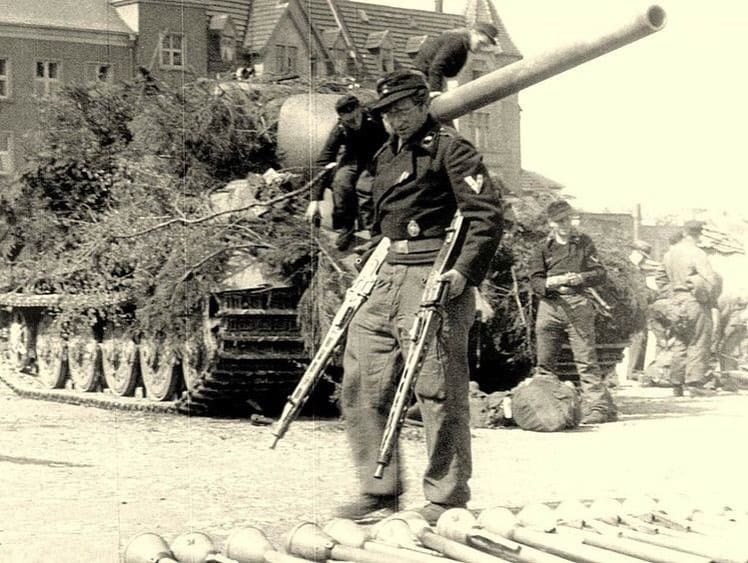
The Pancer ace Albert Ernst was also used in the 512th heavy tank detachment with Jagdtigers from March 1945. After firing tests in the Döllersheim area, the new Jagdpanzers were deployed on 10 March 1945 against the American bridgehead over the Rhine at Remagen.
For the crews, who only had experience with conventional armoured vehicles, fighting in the Jagdtiger offered a number of innovations. The barrel lock and barrel mount of the gun had to be disengaged before the battle. Aiming required the entire vehicle to be levelled, as the 12.8 cm gun was housed in a fixed superstructure.
For Ernst and others who had experience with tank destroyers, the conversion to the Jagdtiger posed few problems.
The German attack on the Remagen bridgehead failed mainly because the attacking forces were deployed piecemeal. Lieutenant General Bayerlein, commanding general of the German LIII Army Corps, suggested that the attack should only begin once all three planned divisions and their heavy weapons were in place.
However, this idea was rejected and he was forced to begin the attack on 10 March. Adolf Hitler had given the order to attack ‘immediately with all available units’.
The attack, in which Ernst Company also took part, was unsuccessful. After the failure of the attack, Ernst and his Jagdtigers were given the task of covering the retreat of the German troops. By the end of March, the 512th Heavy Armoured Battalion had only 13 Jagdtigers left.
At the Ruhrkessel, the Jagdtigers took up positions and took out pursuing American tanks from a distance of two kilometres, proving the outstanding accuracy of the Jagdtiger’s 12.8 cm gun. Ernst and his unit then withdrew to Siegen via Niedernepfen and Obernepfen. From there, a German attack was planned to open up the encirclement ring around the Ruhr area.
Here, too, the Jagdtigers proved their worth, as they could not be penetrated by the American guns from the front. A single hit from the 12.8 cm cannon was enough to shoot an M4 Sherman to pieces.
The battle group was on its own and fighting a hopeless battle, but nobody thought of that at the time. Nevertheless, the American advance had been halted.
Finally, the Americans began to attack, but the German battle group had chosen its position so well that none of the shells hit their target. The American tanks withdrew after four of them had been destroyed at a distance of four kilometres.
However, the supporting three PzKpfw IVs, four assault guns and the four Jagdtigers in the position continued to fire, destroying a large number of trucks and armoured vehicles.
Eventually, all the American vehicles had withdrawn from the range of the German guns.
Later, two of the Jagdtigers were knocked out by P-47 Thunderbolt fighter-bombers after one of the four securing anti-aircraft guns was destroyed by a direct bomb hit and the others ran out of ammunition. However, the flak had also shot down two fighter-bombers beforehand.
The Americans lost a total of 50 vehicles in the battle, including 11 Sherman tanks.
On the evening of 12 April, the Americans began to feel their way forward. The Jagdtigers destroyed two Shermans from a distance of four thousand metres. However, the end was now near, but first there was a ceasefire with the Americans, during which the battle group surrendered the village of Hemer with the large Russian prisoner-of-war camp, contrary to the orders of their command.
On 15 April 1945, the American tanks began to move towards Iserlohn from various directions. Some were destroyed by the Jagdtigers, with Oberleutnant Rondorf shooting down three Shermans on this day alone.
The determined and effective defence by Kampfgruppe Ernst created the conditions for honourable surrender negotiations with the Americans and the avoidance of the destruction of Hemer and Iserlohn, where thousands of refugees were staying. Iserlohn was the only town in the Ruhr pocket where there was a formal surrender.
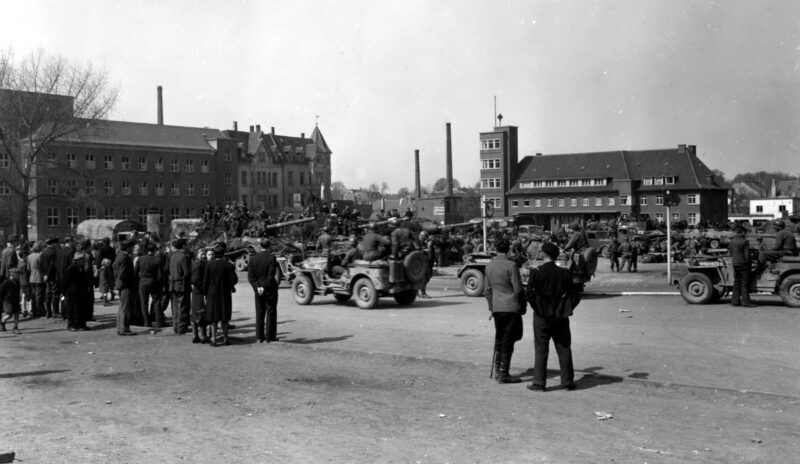
The 1st (Albert Ernst) and 2nd companies (Otto Carius) of the 512th heavy armoured detachment surrendered in the Ruhr pocket, while the 3rd company perished in the fighting in the Harz Mountains.
Legacy and Evaluation
The Jagdtiger’s legacy is marked by its impressive firepower and armor, but also by significant limitations that hampered its effectiveness. Its technical achievements and shortcomings both influenced post-war tank destroyer design philosophy.
Post-War Analysis
Military historians and armor experts have evaluated the Jagdtiger with mixed conclusions. As the heaviest armored fighting vehicle deployed in World War II at 73.5 tonnes, it represented the extreme limits of German heavy tank design.
The 128mm gun provided unmatched firepower, capable of destroying any Allied tank at extreme ranges. However, this came at severe costs to mobility and reliability.
Mechanical breakdowns plagued the Jagdtiger due to its excessive weight and underpowered drivetrain. Many vehicles were abandoned by their crews due to mechanical failures rather than enemy action.
The cost-effectiveness of the Jagdtiger has been questioned by experts. Each vehicle required the same resources as two Panzer IVs, which many argue would have provided more battlefield value.
Influence on Later Designs
Post-war tank destroyer design moved away from the Jagdtiger’s extreme approach. Most nations rejected the concept of massive, heavily-armored tank destroyers in favor of more mobile platforms.
The Jagdtiger demonstrated that mobility and reliability could not be sacrificed for armor and firepower. This lesson influenced NATO and Warsaw Pact vehicle designs throughout the Cold War.
Modern tank destroyers and anti-tank vehicles prioritize speed, deployability, and first-strike capability over heavy armor. Many utilize missiles rather than massive guns, allowing smaller platforms to deliver significant firepower.
The Jagdtiger’s legacy lives on primarily in museums rather than in design influence, with surviving examples displayed at military museums in the United States, United Kingdom, France and Russia.
Preservation and Display
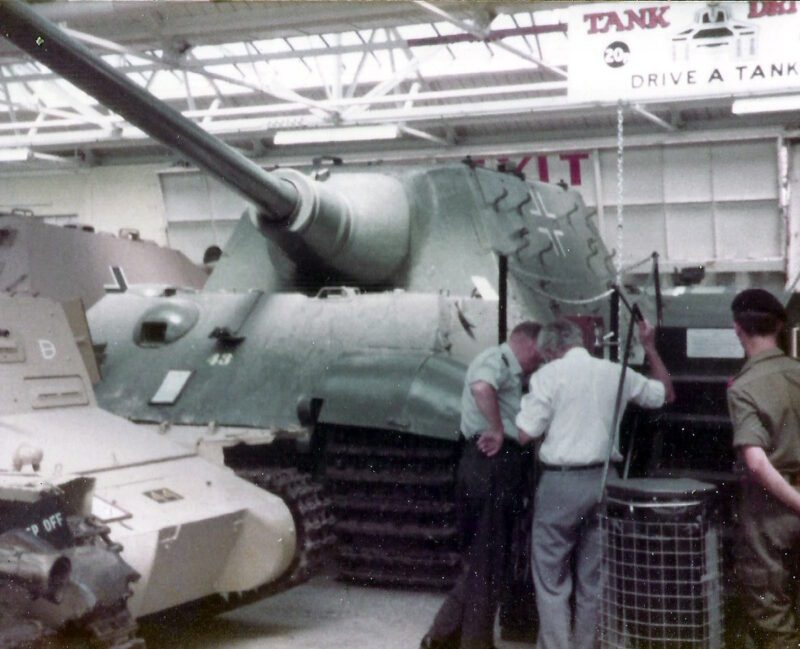
Several Jagdtigers survive today in museums around the world. These rare German heavy tank destroyers from World War II represent important military history artifacts.
The Bovington Tank Museum in England houses a well-preserved Jagdtiger. This example features the Porsche suspension system, making it particularly notable for military vehicle enthusiasts.
The National Armor and Cavalry Museum at Fort Benning, Georgia maintains another Jagdtiger in its collection. This specimen was captured by American forces during the final stages of World War II.
Perhaps the most famous surviving Jagdtiger can be found at the Kubinka Tank Museum in Russia. This example was captured by Soviet forces and transported back to the USSR for technical evaluation.
The German Tank Museum in Munster also displays a Jagdtiger. This vehicle helps visitors understand Germany’s late-war armored vehicle development.
Most preserved Jagdtigers show battle damage or wear from their operational history. Conservation teams work carefully to maintain these massive vehicles, which weigh over 70 tons each.
Museum displays typically highlight the vehicle’s massive 128mm main gun and extremely thick armor protection. Information panels often explain the Jagdtiger’s limited combat effectiveness due to mechanical reliability issues and fuel shortages in the final months of World War II.
Jagdtiger in computer games
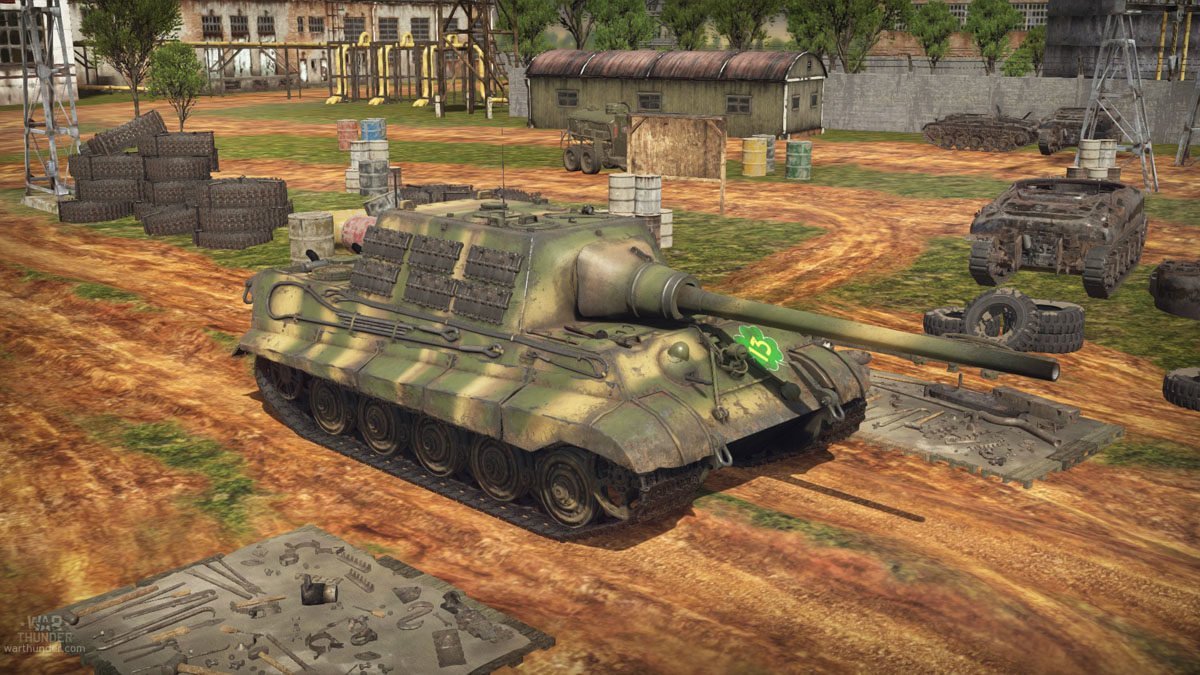
In the following replay video of ‘Realistic ground battles’ in a ‘Realistic land battle’ from the Free-2-Play game War Thunder you can see the effect of the Jagdtiger and the Horten Ho 219 V3:
Who does not know the F2P tank and plane war game War Thunder can download it from here for free:
Frequently Asked Questions
The Jagdtiger generated significant interest among military historians and enthusiasts due to its massive size, formidable armor, and powerful main gun. These features made it a unique war machine despite its operational limitations and technical problems.
What was the primary armament of the Jagdtiger and how did it perform in combat?
The Jagdtiger’s primary armament was the 12.8 cm PaK 44 L/55 gun, one of the most powerful anti-tank guns of World War II. This massive weapon could penetrate almost any Allied tank’s armor at combat ranges.
The gun was highly accurate and devastating when it successfully hit targets. Its shells could destroy American Sherman tanks and Soviet T-34s with a single hit.
However, the gun’s performance in actual combat was limited by several factors. The Jagdtiger’s mechanical reliability issues often prevented it from reaching optimal firing positions, and ammunition supply was limited due to the shell size.
How effective was the Jagdtiger’s armor protection against Allied weapons?
The Jagdtiger featured extremely thick armor protection that made it nearly impervious to most Allied anti-tank weapons. Its frontal armor was 250mm thick at its strongest points.
Most Allied tanks, including the American Sherman and British Churchill, could not penetrate the Jagdtiger’s frontal armor at normal combat ranges. Even the Soviet heavy tanks struggled against this formidable defense.
This protection came at a significant cost, though. The immense weight (72 tonnes) created mechanical stress that led to frequent breakdowns and reduced mobility, making the vehicle vulnerable to flanking attacks and air strikes.
In which battles did the Jagdtiger participate, and what was its impact on the outcomes?
The Jagdtiger saw limited combat action, primarily on the Western Front in the final months of World War II. One notable engagement occurred on March 10, 1945, when Jagdtigers were deployed against American forces at the Remagen bridgehead.
They also participated in defensive operations during the Allied push into Germany in early 1945. Several units equipped with Jagdtigers fought in the Ardennes Offensive (Battle of the Bulge).
Despite their imposing presence, Jagdtigers had minimal impact on battle outcomes. Their limited numbers, mechanical unreliability, and fuel shortages prevented them from significantly influencing the war’s final stages.
How did the production numbers and loss rates of the Jagdtiger compare to other German tank destroyers?
Jagdtiger production was extremely limited compared to other German tank destroyers. Only about 80-88 were built between 1944 and 1945, while thousands of other German tank destroyers like the StuG III were produced.
Loss rates were high relative to production numbers. Many Jagdtigers were abandoned by their crews due to mechanical failures or fuel shortages rather than enemy action.
This contrasts with more successful German tank destroyers like the Jagdpanzer IV and StuG III, which were produced in much larger numbers and maintained better operational readiness.
What are the distinctive features and specifications that set the Jagdtiger apart from its predecessor, the Jagdpanther?
The Jagdtiger was significantly larger and heavier than the Jagdpanther, weighing 72 tonnes compared to the Jagdpanther’s 45.5 tonnes. This made the Jagdtiger far less mobile and more prone to mechanical failure.
The Jagdtiger mounted the massive 12.8 cm gun, while the Jagdpanther used the smaller but still effective 8.8 cm PaK 43 gun. This gave the Jagdtiger greater firepower but at the cost of reduced ammunition capacity.
Armor protection was substantially increased on the Jagdtiger, with up to 250mm of frontal armor compared to the Jagdpanther’s maximum of 80mm. The Jagdpanther was generally considered more successful due to its better balance of protection, firepower, and mobility.
How have surviving Jagdtigers been preserved, and where can they be viewed today?
Several Jagdtigers have survived to the present day and are displayed in museums around the world. The Tank Museum in Bovington, UK, houses one well-preserved example.
Another Jagdtiger can be viewed at the National Armor and Cavalry Museum at Fort Benning, Georgia, USA. This specimen shows the impressive scale of this massive tank destroyer.
The Kubinka Tank Museum in Russia also maintains a Jagdtiger, allowing visitors to see this rare vehicle. These preserved examples provide important insights into German heavy tank design and the engineering challenges faced in creating such massive armored vehicles.
References and literature
Krieg der Panzer (Piekalkiewicz)
The Encyclopedia of Weapons of World War II (Chris Bishop)
Kraftfahrzeuge und Panzer der Reichswehr, Wehrmacht und Bundeswehr (Werner Oswald)
Encyclopedia of German Tanks of World War Two (P.Chamberlain, H.L.Doyle)
Panzer und andere Kampffahrzeuge von 1916 bis heute (Christopher F. Foss, John F. Milsom, Colonel John Stafford Weeks, Captain Georffrey Tillotson, Richard M. Ogorkiewicz)
Panzerkampfwagen des 1. und 2. Weltkrieges (Andrew Kershaw)
Fire and Movement (RAC Tank Museum)
Tigers in Combat I + II (W. Schneider)
Sledgehammers: Strength and Flaws of Tiger Tank Battailions in WWII (C.W.Wilbeck)
Elefant – Jagdtiger – Sturmtiger (Wolfgang Schneider)
Tiger tanks (Michael Green)
Der Panzer-Kampfwagen Tiger und seine Abarten (Walter J.Spielberger, Hilary L.Doyle)
Panzer Aces I-III (Franz Kurowksi)



